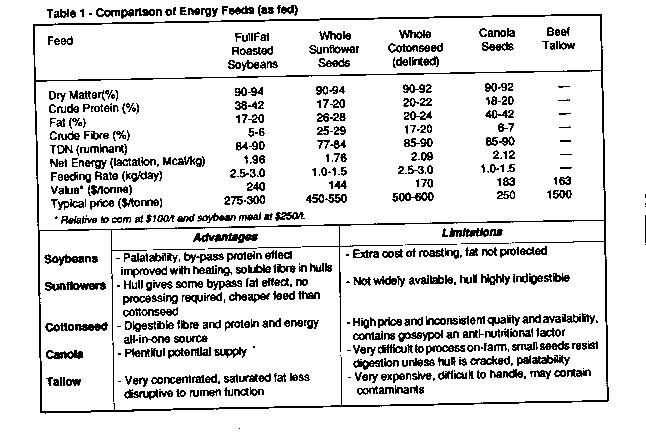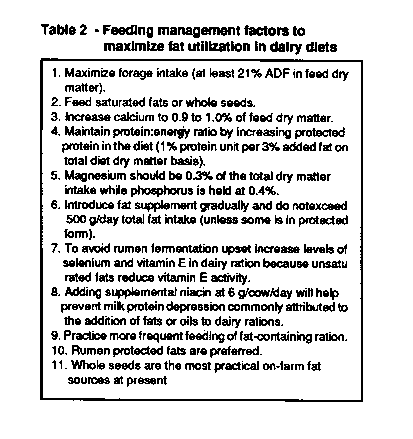
Sustainable Farming Index | Virtual Library | Magazine Rack
Search
| Ecological Solutions Roundtable
by Jeff Quinn
Today's dairy farmers are being challenged more than ever before to produce milk efficiently and economically. Attentive management, particularly with regard to feeds and feeding strategies, is the key to higher performance and profitability. Sunflowers - a potential home-grown source of energy and bypass fat - may be a ray of hope in enhancing a herd's overall performance without the expense and intake problems associated with commercial sources.
The genetic capacity of today's dairy cow to produce milk often far exceeds the ability of microbial digestion in their rumor s to provide nutrients. This problem is most evident in early lactation when maximum feed intake lags behind maximum milk production. As a result, high producing cows usually suffer considerable loss of body weight and reduced reproductive performance, both affecting the economic bottom line.
However, attempting to reduce this energy deficit problem by feeding more energy at the expense of roughage causes digestive disorders that result in lower milk production end Butterfat test. Added fat and oils are therefore regularly included in early lactation rations to increase the energy density without sacrificing roughage intake. Unfortunately, commercial sources of by-pass fat are expensive and sometimes highly unpalatable.
Steve Zehr of Tavistock, Ontario began top dressing whole sunflower seeds to his early lactation cows following the suggestion of a Wisconsin dairy nutritionist. "We simply could not get the cows to eat Megalac (a commercial by-pass fat product) and sunflower seeds were much more available than cottonseed" says Zehr.
The by-pass energy effect of sunflowers is only achieved when the cows are fed whole sunflower seeds without any processing other than drying. It is the highly indigestible hull which physically protects the highly degradable unsaturated oil in the sunflower seed from being released too quickly, thus giving the by-pass fat effect. Typically 1.0 to 1.5 kg per cow per day of whole sunflower seeds can be topdressed or blended into a total mixed ration without a negative impact on fibre digestion.
Tom Droppo, a dairy cattle specialist from Manitoba, advises caution when feeding sunflower seeds. "Pay attention to the oil content to avoid exceeding 0.5 kg total supplementary fat intake from sunflower oil," he says, adding that ``the sunflower oil is a good source of extra energy and should be fed as an energy source similar to cottonseed."
Because of the sunflowers' higher oil content, the recommended feeding level is half of that for whole cottonseed or roasted whole soybeans (1 to 1.5 kg/ cow/day versus 2.5 to 3 kg/cow/day), but similar to whole canola seed (see table 1).

It is most economical to feed supplementary fats in weeks 5 through 20 in the lactation. According to Dr. D. L. Palmquest of Ohio State University, cows are geared toward mobilizing fats from their own bodies initially in early lactation and do not respond to dietary fats until about week 5.
However, it is important to have some of the fat source, such as sunflower, in the ration early to familiarize the cows and acclimatize their rumen. The feeding rates should increase when the cows begin to respond with increasing milk production and intake. After 20 weeks, cows can consume adequate amounts of digestible energy without the need for supplementary fat.
Ray Ingles, a Manitoba dairy nutritionist, suggests that of the 6 to 8 per cent total dietary fat intake, the first 2 to 2.5% (0.4 to 0.45 kg) is present in the feed stuff, the second 2.5 to 3 per cent (0.5 to 0.6 kg) can be added as tallow or whole oil seed, and any additional fat source up to 2 per cent (0.4 to 0.6 kg) must be protected (e.g. Megalac).
``If 0.6 kg of straight sunflower oil is added to the diet there will be a negative effect on fibre digestion and fat test. But as a component of whole seed, no such negative effect is observed'' Ingles warns.
This underscores the importance of leaving the hull intact to give the `'fat production" effect. Ingles points to the indigestible hull as a limitation in sunflowers relative to the digestible fibre in soybeans and cottonseed hulls. However, the possible slower turnover of rumen content must be weighed against the increased ``rumen scratch'' effect that stimulates more cud-chewing and production.
The protein content of sunflower, like other oilseeds, is highly degradable so a bypass protein source must be fed along with the seeds to maximize the efficiency of utilization (see table 2).

Zehr obtained his sunflower supply from a grower near Nanticoke, Ontario to supplement his dairy feed and noticed that "right away, a shine comes on the coats of the cows".
After three months on sunflower power, he believes cows in early lactation are better maintaining body condition scores - "a visible indicator of a reduced energy deficit". Milk production in the Zehr herd has held steady but "butterfat jumped 4 tenths of a point within 3 weeks." Cows receive a maximum of 1.3kgs per day and first-calf heifers a maximum of 0.9kgs per day by 8 to 1 0 weeks after parturition.
In contrast to the component feeding system in the Zehrherd, Ron MacKay of Embro, Ontario feeds a total mixed ration. "The high producer ration is balanced to 32kgs per day production and top milkers are top-dressed extra according to production" notes MacKay. He includes 1.3kgs daily of sunflower seeds for cows at peak production without any obvious problems on a haylage based ration.
MacKay is pleased with initial results but feels it is too early to draw any firm conclusions. He was impressed, however, with how the sunflower seeds Work well on the top end cows with production gains of 1.75-2.25kgs per day, even on those milking 45kgs per day!" The sunflowers' effect on milk production was most evident when they discontinued feeding the sunflowers for 3 weeks and then went back on them again.
In Minnesota, Dr. Ken Nordland of the University of Wisconsin worked with 20 producers who fed whole sunflower seeds to dairy cows for two years. Most of these were already high production herds, yet the typical response was a 6 to 8 per cent increase in milk production. Total butterfat and protein production also increased despite a slight decrease in butterfat and protein percentage.
Assuming a 6 per cent increase in milk production in a herd with a 7,000 kg/cow average, an extra 420 kg milk would be produced per lactation per cow, or $204/cow at milk priced at $50/hl. Feeding an average of 1 kg sunflower seed per day doer cow from week 5 through week 20 translates into a cost of $56 per cow based on $500/t for sunflower seeds. That's a $148/cow/lactation extra return, or nearly a threefold return on investment! The possible gains are not, however, without risk.
Agronomically, there are some real hazards to small scale sunflower production. Insect, disease and bird damage are magnified on small acreages. The warm, moist climate of Ontario and Quebec can accentuate insect and disease problems where heavy yield losses from lodging, as well as from head and stalk rot (Sclerotinia white mold), are common. Care must be taken not to follow canola, soybeans or white beans in the rotation as these crops are carriers of the white mold. In a rotation plan, it is best to follow a hay crop.
The sunflower moth, whose larvae eat the sunflower meat and leave an empty seed shell, can also be a problem. Sunflowers have been tested as a silage crop and this might be a viable option in the case of adverse conditions where seed production looks doubtful.. Dry down can be slow and ripening can be uneven. There are few registered herbicides for weed control. In addition, harvesting equipment, such as a John Deere all-crop head or combine headers fitted with extended pans, is required to avoid excessive harvest losses. Special attention must be given to drying down the fragile seeds to the 10 per cent moisture level at which they store without spoilage because of the danger of the dryers catching fire.
In the words of sunflower grower Jim Beer, The first priority of the dairyman is to his cows and not spending a At of time fussing over a specialty crop." He estimates a minimum of 12 to 15 acres are required to make sunflowers a feasible crop, this assuming one has access to proper harvesting equipment or can modify what is presently available.
On the positive side, sunflowers can be planted with a corn planter (plateless) and have lower fertility requirements and greater drought tolerance than corn. They respond to some pop-up phosphorous starter and 40-45 kg per acre of actual nitrogen with no extra potash needed. Perhaps best of all, there are no marketing boards so an enterprising individual could grow as much as he could market privately, perhaps supplying the needs of local dairy herds.
The greatest potential for sunflowers in the dairy ration is as a source of bypass fat for direct energy to the cow. Trials have demonstrated sunflowers to be cost effective and nutritionally sound when fed according to specific guidelines. Sunflowers are a practical on-farm source of fat energy for dairy cattle; although production risks must be considered, the sunshine crop's bright returns may give dairy farmers something to smile about.
Copyright © 1991 REAP Canada.
Reprinted with permission. All rights reserved.
Info Request | Services | Become EAP Member | Site Map
Give us your comments about the EAP site
Ecological Agriculture Projects, McGill University (Macdonald
Campus),
Ste-Anne-de-Bellevue, QC, H9X 3V9 Canada
Telephone:
(514)-398-7771
Fax:
(514)-398-7621
Email: info@eap.mcgill.ca
To report problems or otherwise comment on the structure of this site, send mail to the Webmaster